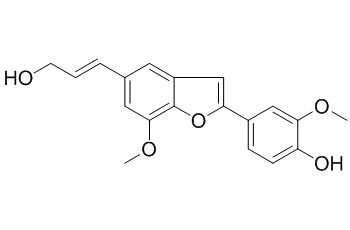Ailanthoidol
Ailanthoidol has anti-inflammatory activity, it inhibits inflammatory reactions by macrophages and protects mice from endotoxin shock. It also possesses potential as a chemopreventive agent against tumor promotion. Ailanthoidol has anti-adipogenic activity, it effectively suppresses adipogenesis and that it exerts its role mainly through the significant down-regulation of PPARγ and C/EBPα expression.
Inquire / Order:
manager@chemfaces.com
Technical Inquiries:
service@chemfaces.com
Tel:
+86-27-84237783
Fax:
+86-27-84254680
Address:
1 Building, No. 83, CheCheng Rd., Wuhan Economic and Technological Development Zone, Wuhan, Hubei 430056, PRC
Providing storage is as stated on the product vial and the vial is kept tightly sealed, the product can be stored for up to
24 months(2-8C).
Wherever possible, you should prepare and use solutions on the same day. However, if you need to make up stock solutions in advance, we recommend that you store the solution as aliquots in tightly sealed vials at -20C. Generally, these will be useable for up to two weeks. Before use, and prior to opening the vial we recommend that you allow your product to equilibrate to room temperature for at least 1 hour.
Need more advice on solubility, usage and handling? Please email to: service@chemfaces.com
The packaging of the product may have turned upside down during transportation, resulting in the natural compounds adhering to the neck or cap of the vial. take the vial out of its packaging and gently shake to let the compounds fall to the bottom of the vial. for liquid products, centrifuge at 200-500 RPM to gather the liquid at the bottom of the vial. try to avoid loss or contamination during handling.
University of Stuttgart2021, 11682.
Eur Endod J.2020, 5(1):23-27.
Appl. Sci. 2024, 14(13), 5815
Korean Journal of Medicinal Crop Science2018, 26(5):382-390
Biomed Pharmacother.2023, 162:114617.
China Pharmacy2015, 26(27)
Front Mol Neurosci.2023, 15:1083189.
J Agric Food Chem.2015, 63(44):9869-78
J Sep Sci.2019, 42(21):3352-3362
Front Plant Sci.2022, 13:982771.
Related and Featured Products
J Cell Biochem. 2011 Dec;112(12):3816-23.
Ailanthoidol suppresses lipopolysaccharide-stimulated inflammatory reactions in RAW264.7 cells and endotoxin shock in mice.[Pubmed:
21826708]
The biological properties of Ailanthoidol, a neolignan from Zanthoxylum ailanthoides or Salvia miltiorrhiza Bunge, which is used in Chinese traditional herbal medicine, have not been evaluated.
METHODS AND RESULTS:
Here, we report that Ailanthoidol inhibits inflammatory reactions in macrophages and protects mice from endotoxin shock. Our in vitro experiments showed that Ailanthoidol suppressed the generation of nitric oxide (NO) and prostaglandin E(2) , as well as the expression of inducible NO synthase (iNOS) and cyclooxygenase (COX)-2 induced by lipopolysaccharide (LPS) in RAW264.7 cells. Similarly, Ailanthoidol inhibited the production of inflammatory cytokines induced by LPS in RAW264.7 cells, including interleukin (IL)-1β and IL-6. In an animal model, Ailanthoidol protected BALB/c mice from LPS-induced endotoxin shock, possibly through inhibition of the production of inflammatory cytokines and NO.
CONCLUSIONS:
Collectively, Ailanthoidol inhibited the production of inflammatory mediators and may be a potential target for treatment of various inflammatory diseases.
대한의생명과학회지, 2014, 20:62-69.
Anti-Adipogenic Activity of Ailanthoidol on 3T3-L1 Adipocytes.[Reference:
WebLink]
Previous our study demonstrated that Ailanthoidol (3-deformylated 2-arylbenzo[b]furan), a neolignan from Zanthoxylum ailanthoides or Salvia miltiorrhiza Bunge, is a novel anti-inflammatory agent.
METHODS AND RESULTS:
In this investigation, we examined the anti-adipogenic effect of Ailanthoidol. Our data showed that Ailanthoidol suppressed lipid droplet formation and adipocyte differentiation in 3T3-L1 cells. Treatment of the 3T3-L1 adipocytes with Ailanthoidol resulted in an attenuation of the releases of leptin and interleukin-6. The expression of peroxisome proliferator-activated receptor (PPAR)γ and CCAAT/ enhancer-binding protein (C/EBP)α, the central transcriptional regulators of adipogenesis, was decreased by treatment with Ailanthoidol. Additionally, Ailanthoidol treatment increased the phosphorylation levels of 5" adenosine monophosphateactivated protein kinase.
CONCLUSIONS:
These results suggest that Ailanthoidol effectively suppresses adipogenesis and that it exerts its role mainly through the significant down-regulation of PPARγ and C/EBPα expression.
Our findings provide important insights into the mechanisms underlying the anti-adipogenic activity of Ailanthoidol.
Oncol Rep. 2006 Oct;16(4):921-7.
Inhibitory effect of ailanthoidol on 12-O-tetradecanoyl-phorbol-13-acetate-induced tumor promotion in mouse skin.[Pubmed:
16969515]
Many components derived from dietary or medicinal plants showing antioxidant and anti-inflammatory potential have been found to possess chemopreventive properties. In our previous study, we achieved the total synthesis of Ailanthoidol (AT), a neolignan from Zanthoxylum ailanthoides or Salvia miltiorrhiza Bunge, which are used in Chinese traditional herbal medicine.
METHODS AND RESULTS:
In the present study, preliminarily, AT exhibited a radical quenching property by DPPH assay. Following this, we assessed the effect of AT on 12-O-tetradecanoylphorbol-13-acetate (TPA)-induced oxidative stress and inflammation in female CD-1 mouse skin which was closely linked to tumor promotion. The topical application of AT (0.5-2.5 mM; 200 microl) reduced the formation of hydrogen peroxide and inhibited the myeloperoxidase (MPO) activity in the mouse skin when compared with that of the TPA-treated alone group. In addition, AT presented a suppression effect on the TPA-induced hyperplasia and leukocyte infiltration in the epidermis and edema of mouse ears. Furthermore, it showed that AT inhibited the TPA-induced expression of COX-2 protein and ornithine decarboxylase (ODC) activity in epidermis. Finally, AT was evaluated for its ability to inhibit the TPA-induced promotion in skin tumors of female CD-1 mice. Topical application of AT 5 min prior to TPA (5 nmol) three times weekly for 12 weeks to mice which were initiated with benzo[a]pyrene (B[a]P) inhibited the incidence of skin tumors in mice and the average number of tumors per mice as compared to TPA-treated alone.
CONCLUSIONS:
These results indicate that AT possesses potential as a chemopreventive agent against tumor promotion.



